|
|
Post by Joey12 on May 28, 2021 8:48:27 GMT
Hard to believe but I saw a vulture today that looked about the same size. 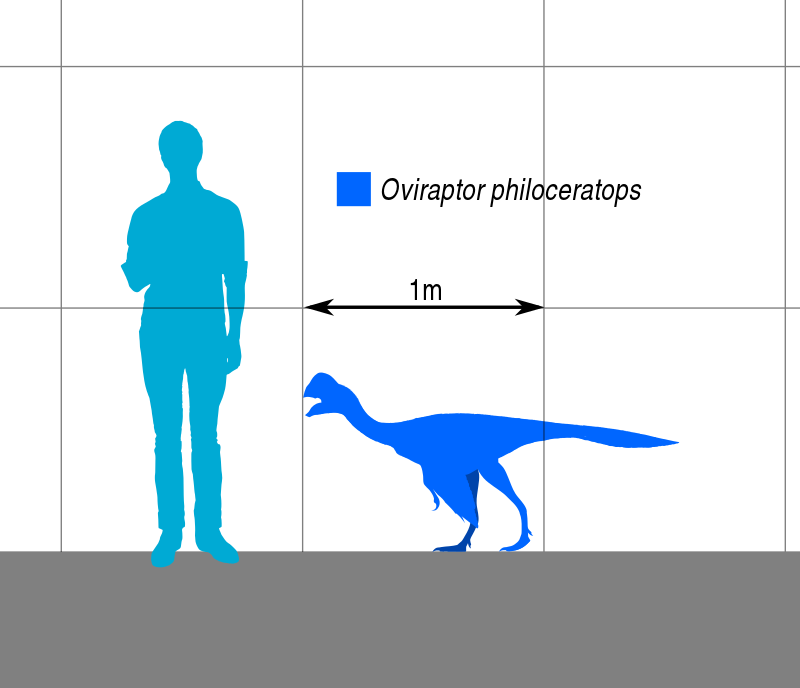 |
|
|
|
Post by Joey12 on May 28, 2021 8:54:32 GMT
Hmm this one may have eaten ME!!! 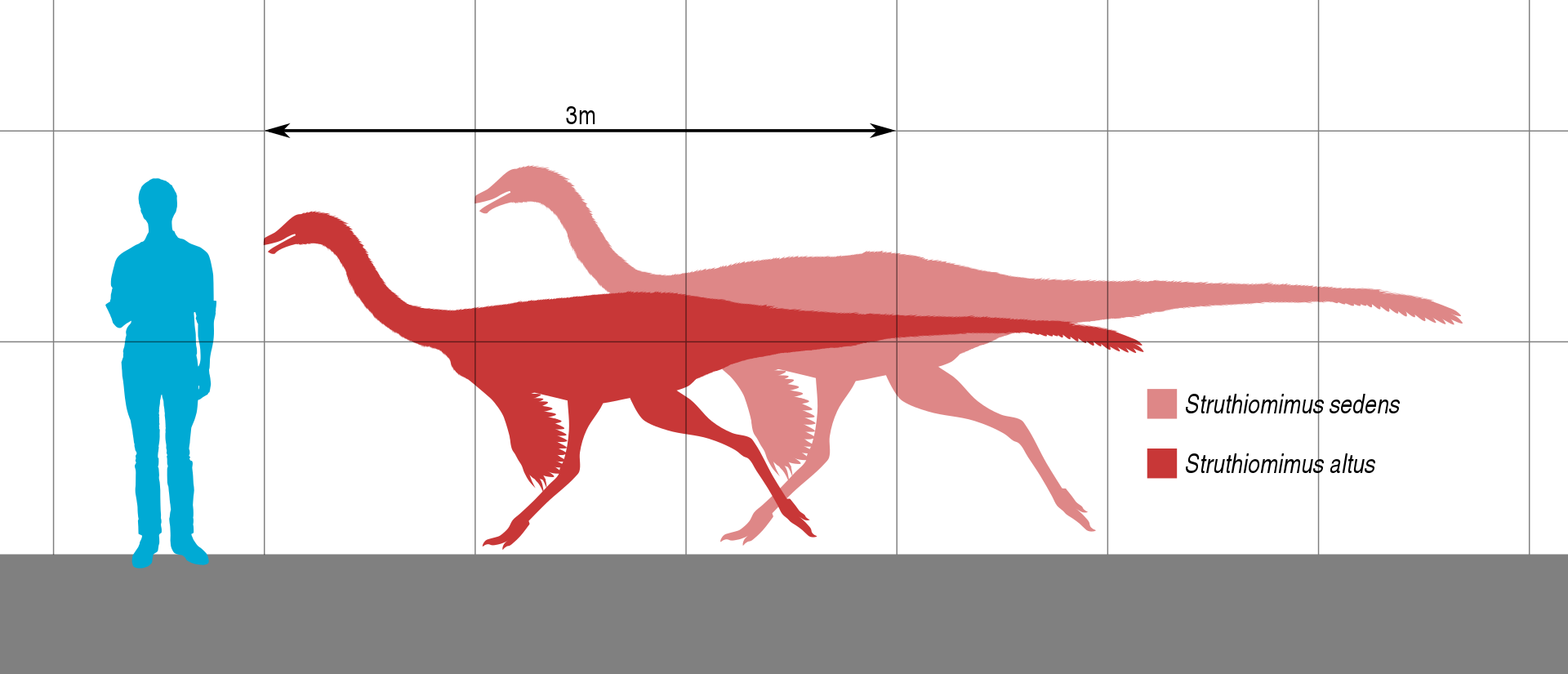 |
|
|
|
Post by Talira Greycrest on May 28, 2021 13:39:07 GMT
Like modern ostriches, Ornithomimids, such as Struthiomimus, didn't have any teeth. Therefore, there's been much discussion about what they may have eaten. It's been suggested that they had a mixed diet of fruit, seeds and small animals including lizards, rodents and insects.
|
|
|
|
Post by Talira Greycrest on May 28, 2021 14:09:46 GMT
And the award for 'Dinosaur with the strangest name' goes to....Irritator!
Pronunciation: Ih-re-tay-tor
Meaning of name: "Irritating", in reference to the frustration felt by palaeontologists having to repair the damage illegal collectors had done to the only known fossils.
Species: I. challengeri
Size: Estimated to have measured around 8 metres long, 2.5 metres tall and weighing between 1 and 4 metric tonnes.
Family: Spinosauridae.
Diet: Carnivore.
First fossils found: Known only from a skull and some vertebrae discovered by commercial fossil poachers in the Romualdo Formation of northeastern Brazil in 1996. In hopes of making the skull look more complete and, therefore, more valuable, the collectors tried to reconstruct it by grafting parts of the upper jaw to the snout before illegally selling it to a museum in Germany. When palaeontologists finally got the skull, they had to work for hours to repair the damage the collectors had done before they could identify what type of dinosaur they had. Named in the same year by D. M. Martill, A. R. I. Cruikshank, E. Frey, P. G. Small and M. Clarke.
Lived: 110 million years ago during the Albian stage of the Early Cretaceous in what is now northeastern Brazil.
|
|
|
|
Post by Joey12 on May 29, 2021 6:53:22 GMT
Would want to run across one of these even though it's on the small side of the family.
|
|
|
|
Post by Talira Greycrest on May 29, 2021 8:25:28 GMT
A dino made famous by its appearance in the Jurassic Park franchise: Name: VelociraptorPronunciation: Veh-loss-ah-rap-tor.Meaning of name: "Fast thief".Species: V. mongoliensis, V. osmolskae.Size: 2 metres long, 1 metre tall and weighing around 15kgs.Family: Dromaeosauridae.Diet: Carnivore.First fossils found: Known from several specimens, the first of which was discovered by Peter Kaisen in Mongolia's Gobi Desert in 1923. V. mongoliensis named by American palaeontologist, Henry Fairfield Osborne, in 1924. V. osmolskae named by Belgian palaeontologist, Pascal Godefroit, in 2008. In 1971, a remarkable fossil was discovered. It's known as the "Fighting Dinosaurs" and preserves a Velociraptor in battle with a Protoceratops.Lived: 75 to 71 million years ago during the Campanian and Maastrichtian stages of the Late Cretaceous in what is now southern Mongolia.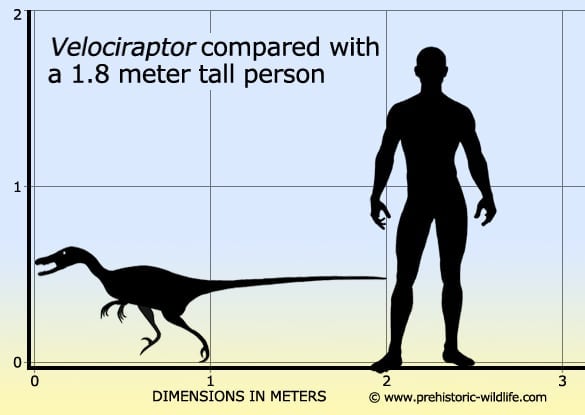 |
|
|
|
Post by Talira Greycrest on May 29, 2021 8:38:17 GMT
Would want to run across one of these even though it's on the small side of the family. 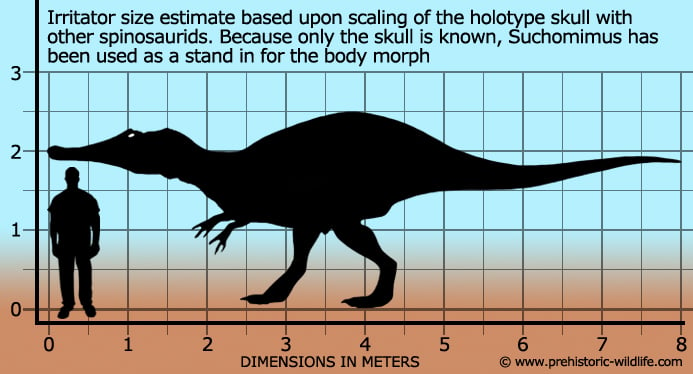 |
|
|
|
Post by Talira Greycrest on May 29, 2021 13:18:21 GMT
This dino has a small part in 'Jurassic Park 3': Name: CeratosaurusPronunciation: See-rat-oh-sore-usMeaning of name: "Horned lizard", in reference to the stumpy horn on its snout.Species: C. nasicornis, C. dentisulcatus, C. magnicornis. It's possible there may be other species.Size: Estimated to have measured between 6 and 7 metres long, between 2 and 3 metres tall and weighing up to 700kgs.Family: Ceratosauridae.Diet: Carnivore.First fossils found: Known from several specimens, the first of which was discovered in the Morrison Formation of Colorado by farmer Marshall Parker Felch. C. nasicornis named by American palaeontologist, Othniel Charles Marsh, in 1884. C. dentisulcatus and C. magnicornis named in 2000.Lived: Depending on species, from 157.3 to 145 million years ago during the Kimmeridgian and Tithonian stages of the Late Jurassic in what is now Portugal and the western United States. May also have lived in what is now Switzerland, Tanzania and Uruguay.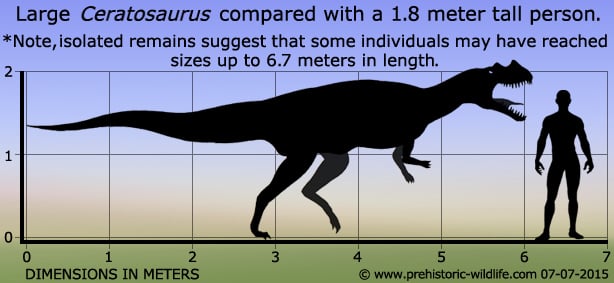 The Ceratosaurus scene in 'Jurassic Park 3' The Ceratosaurus scene in 'Jurassic Park 3' |
|
|
|
Post by Joey12 on May 30, 2021 5:46:13 GMT
I can't see myself standing and looking one of there in the eye. They would be looking at the back of my head as I got out of there.
|
|
|
|
Post by Talira Greycrest on May 30, 2021 6:08:45 GMT
My favourite Sauropod and one of the tallest dinosaurs of the Late Jurassic: Name: BrachiosaurusPronunciation: Brak-he-o-sore-us.Meaning of name: "Arm lizard", because the front legs are longer than the hind legs to provide support for the 9-metre-long neck.Species: B. altithoraxSize: Estimated to have Measured between 18 and 22 metres long, between 10 and 15 metres tall and weighing between 28 and 60 metric tonnes.Family: Brachiosauridae.Diet: Herbivore. Fed on high-growing vegetation.First fossils found: Known from several specimens, the first of which was discovered by American palaeontologist, Elmer Samuel Riggs, in the Morrison Formation of Colorado in 1900. Named by Mr. Riggs in 1903.Lived: 154 to 153 million years ago during the Kimmeridgian stage of the Late Jurassic in what is now the western United States.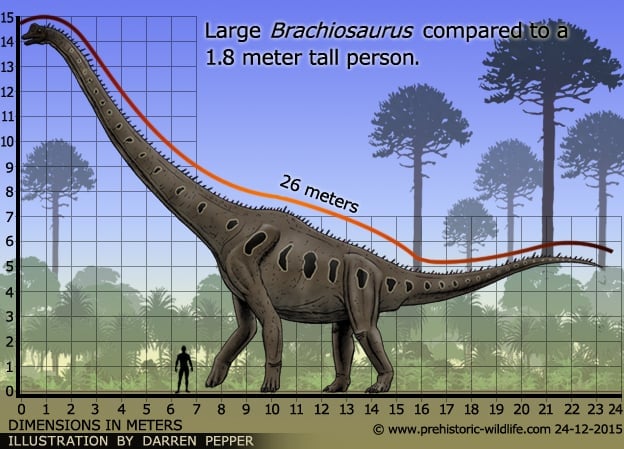 |
|
|
|
Post by Joey12 on May 30, 2021 6:13:05 GMT
Guess you can't even look this one right in the eye.
|
|
|
|
Post by Talira Greycrest on May 30, 2021 10:24:39 GMT
Guess you can't even look this one right in the eye. You could if you climbed a really tall tree. There were definite advantages to being so big and tall. Sauropods could reach vegetation that other herbivores couldn't get to and, if they were lucky enough to reach their full adult size, only old age and the largest predators of the time would have been considered a threat. |
|
|
|
Post by Talira Greycrest on May 30, 2021 13:18:48 GMT
Another dino made famous by its appearance on the big screen: Name: DilophosaurusPronunciation: Di-lo-fo-sore-us.Meaning of name: "Two-crested lizard", in reference to the v-shaped crest on its head.Species: D. wetherilliSize: 6 metres long, 2 metres tall and weighing around 400kgs.Family: Dilophosauridae.Diet: Carnivore.First fossils found: Known from three mostly complete skulls and skeletons. First discovered by a field party from the University of California Museum of Paleontology in the Kayenta Formation of northern Arizona in 1942. Named by American palaeontologist, Samuel Paul Welles, in 1970. Was originally thought to be a species of Megalosaurus. Contrary to popular belief, there's no evidence to suggest that Dilophosaurus had an extendable neck frill or used venom to kill its prey.Lived: 193 million years ago during the Sinemurian stage of the Early Jurassic in what is now the southwestern United States.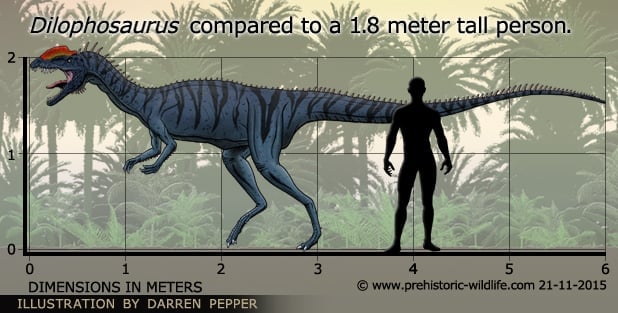 |
|
Tix Mascot
Tech guru
Italy is my second homeland
Posts: 11,071  Mini-Profile Background: {"image":"http://4.bp.blogspot.com/-X5mhw13BJ7Y/TwKeZ3uM7YI/AAAAAAAABPw/D82go4Ny_8E/s1600/italy-background-8-787281.jpg","color":""}
Mini-Profile Text Color: 0ef8f1
Mini-Profile Name Color: f40d39
Year of Birth: 1961
Nationality: Norwegian
Mini-Profile Background: {"image":"http://4.bp.blogspot.com/-X5mhw13BJ7Y/TwKeZ3uM7YI/AAAAAAAABPw/D82go4Ny_8E/s1600/italy-background-8-787281.jpg","color":""}
Mini-Profile Text Color: 0ef8f1
Mini-Profile Name Color: f40d39
Year of Birth: 1961
Nationality: Norwegian
|
Post by Tix Mascot on May 30, 2021 23:24:05 GMT
Much interesting stuff here, Tal!  |
|
|
|
Post by Talira Greycrest on May 31, 2021 5:18:12 GMT
Over the years, palaeontologists have named hundreds of different dinosaurs, but this one was the first herbivorous dinosaur to be officially named, way back in 1825. Name: IguanodonPronunciation: Ig-wah-no-don.Meaning of name: "Iguana tooth", because its teeth are similar in appearance to those of a modern Iguana.Species: I. bernissartensis, I. galvensis.Size: Between 10 and 13 metres long, 3 metres tall (up to 6 metres when standing upright) and weighing between 4 and 5 metric tonnes.Family: Iguanodontidae.Diet: Herbivore. Fed on both high and low-growing vegetation.First fossils found: Known from several specimens. The first specimen, a handful of teeth, was discovered by English doctor and palaeontologist, Gideon Mantell, in southeast England in 1822. Named by Mr. Mantell in 1825. First skeleton discovered in 1834. The largest-known discovery of Iguanodon fossils occurred in February 1878, when miners in the Bernissart coal mine came across the skeletons of 38 individuals. These skeletons are now on display at the Royal Belgian Institute of Natural Sciences.Lived: 126 to 122 million years ago during the Barremian and Aptian stages of the Early Cretaceous in what is now Belgium, Portugal, Germany, Spain and England.
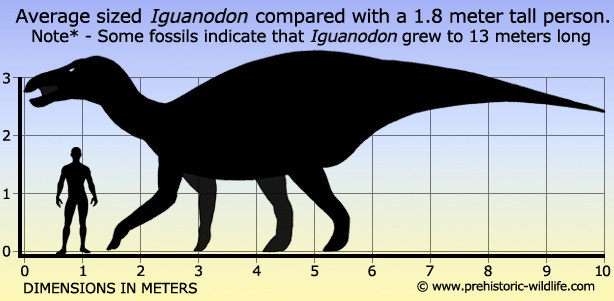 |
|